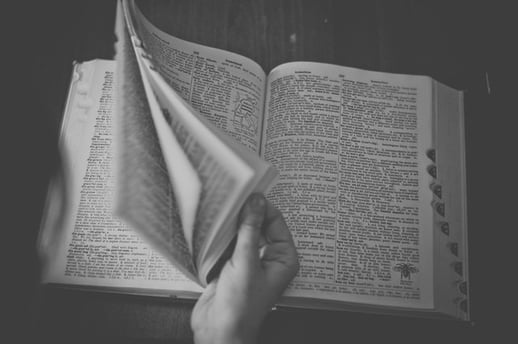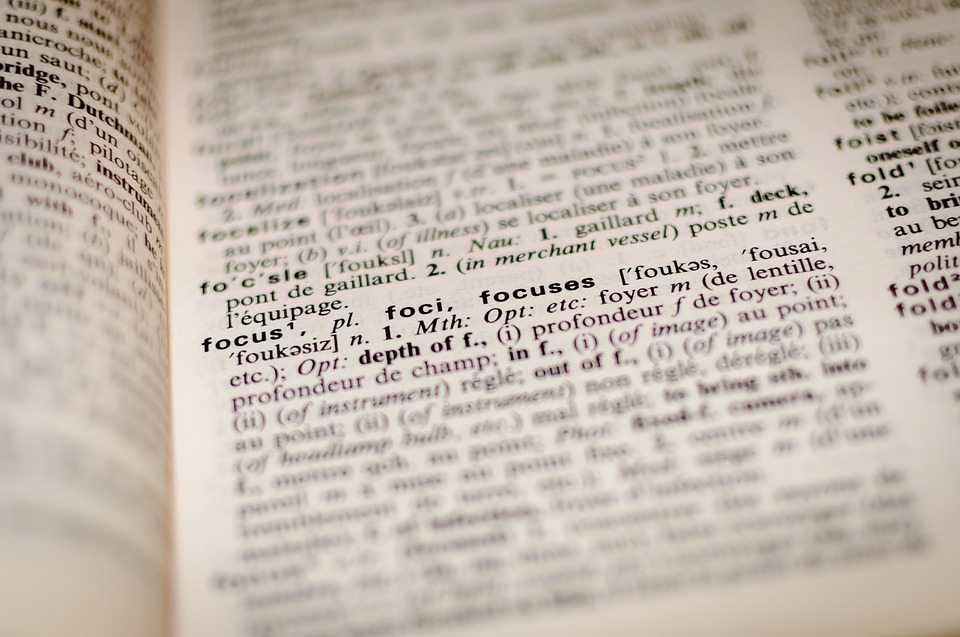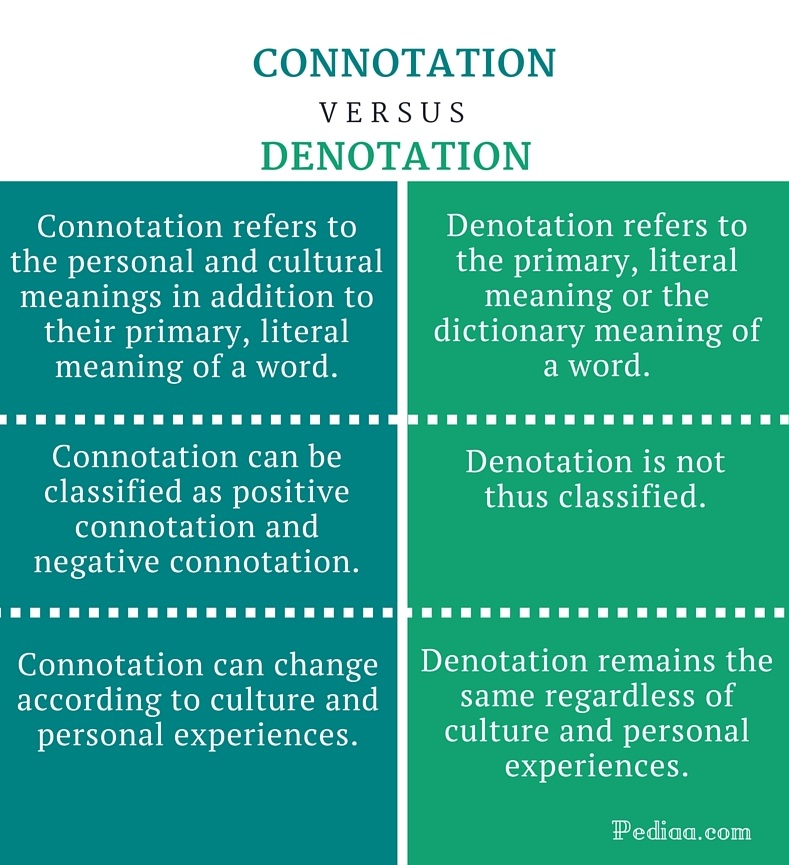Proceeding
with the semantic analysis we observe that lexical meaning is not
homogenous either and may be analysed as including denotational and
connotational components.
As
was mentioned above one of the functions of words is to denote
things, concepts and so on. Users of a language cannot have any
knowledge or thought of the objects or phenomena of the real world
around them unless this knowledge is ultimately embodied in words
which have essentially the same meaning for all speakers of that
language. This is the denotational
meaning,
i.e. that component of the lexical meaning which makes communication
possible. There is no doubt that a
physicist
knows more about the atom than a singer does, or that an arctic
explorer possesses a much deeper knowledge of what arctic ice is like
than a man who has never been in the North. Nevertheless they use the
words atom,
Arctic, etc.
and understand each other.
The
second component of the lexical meaning is the connotational
component,
i.e. the emotive charge and the stylistic value of the word.
20
§ 9. Emotive Charge
Words
contain an element of emotive evaluation as part of the connotational
meaning; e.g. a
hovel denotes
‘a small house or cottage’ and besides implies that it is a
miserable dwelling place, dirty, in bad repair and in general
unpleasant to live in. When examining synonyms large,
big, tremendous and
like,
love, worship or
words such as girl,
girlie; dear, dearie we
cannot fail to observe the difference in the emotive charge of the
members of these sets. The emotive charge of the words tremendous,
worship and
girlie
is
heavier than that of the words large,
like and
girl.
This
does not depend on the “feeling” of the individual speaker but is
true for all speakers of English. The emotive charge varies in
different word-classes. In some of them, in interjections, e.g., the
emotive element prevails, whereas in conjunctions the emotive charge
is as a rule practically non-existent.
The
emotive
charge
is one of the objective semantic features proper to words as
linguistic units and forms part of the connotational component of
meaning. It should not be confused with emotive
implications
that the words may acquire in speech. The emotive implication of the
word is to a great extent subjective as it greatly depends of the
personal experience of the speaker, the mental imagery the word
evokes in him. Words seemingly devoid of any emotional element may
possess in the case of individual speakers strong emotive
implications as may be illustrated, e.g. by the word hospital.
What
is thought and felt when the word hospital
is
used will be different in the case of an architect
who built it, the invalid staying there after an operation, or
the man living across the road.
§ 10. Sfylistic Reference
Words differ not only in
their emotive charge but also in their stylistic reference.
Stylistically words can be roughly subdivided into literary, neutral
and colloquial layers.1
The
greater part of the literаrу
layer
of Modern English vocabulary are words of general use, possessing no
specific stylistic reference and known as neutral
words.
Against the background of neutral words we can distinguish two major
subgroups —
standard
colloquial
words and literary
or bookish
words. This may be best illustrated by comparing words almost
identical in their denotational meaning, e. g., ‘parent
— father — dad’. In
comparison with the word father
which
is stylistically neutral, dad
stands
out as colloquial and parent
is
felt as bookish. The stylistic reference of standard colloquial words
is clearly observed when we compare them with their neutral synonyms,
e.g. chum
— friend, rot
— nonsense,
etc.
This is also true of literary or bookish words, such as, e.g., to
presume (cf. to suppose), to anticipate (cf. to expect) and
others.
Literary
(bookish) words are not stylistically homogeneous. Besides
general-literary (bookish) words, e.g. harmony,
calamity, alacrity, etc.,
we may single out various specific subgroups, namely: 1)
terms
or
1
See
the stylistic classification of the English vocabulary in:
I.
R.
Galperin. Stylistics.
M., 1971,
pp.
62-118.
scientific
words such as, e g., renaissance,
genocide, teletype, etc.;
2)
poetic
words and archaisms such as, e.g., whilome
— ‘formerly’,
aught
— ‘anything’,
ere
— ‘before’,
albeit
— ‘although’,
fare
— ‘walk’,
etc., tarry
— ‘remain’,
nay
— ‘no’;
3)
barbarisms
and foreign words, such as, e.g., bon
mot
— ‘a
clever or witty saying’, apropos,
faux pas, bouquet, etc.
The colloquial words may be subdivided into:
-
Common colloquial words.
-
Slang,
i.e. words which are often regarded as a violation of the norms of
Standard English, e.g. governor
for
‘father’, missus
for
‘wife’, a gag
for
‘a joke’, dotty
for
‘insane’. -
Professionalisms,
i.e. words used in narrow groups bound by the same occupation, such
as, e.g., lab
for
‘laboratory’, hypo
for
‘hypodermic syringe’, a
buster for
‘a bomb’, etc. -
Jargonisms,
i.e. words marked by their use within a particular social group and
bearing a secret and cryptic character, e.g. a
sucker
— ‘a
person who is easily deceived’, a
squiffer —
‘a
concertina’. -
Vulgarisms,
i.e. coarse words that are not generally used in public, e.g.
bloody,
hell, damn, shut up, etc.
-
Dialectical
words, e.g. lass,
kirk, etc. -
Colloquial
coinages, e.g. newspaperdom,
allrightnik, etc.
Confused about the difference between connotation and denotation? Not sure how it’s possible for one word to have many connotations? Connotation and denotation both refer to word meanings, but they’re very different concepts. Read this guide to learn the denotation definition, connotation definition, how you can remember which is which, and what connotation and denotation examples look like.
Denotation Definition
Denotation is the literal meaning of a word. It’s the definition you would find in the dictionary. For example, if you were to look up the word “proud” in the dictionary, a typical entry would read, “having or showing self-respect or self-esteem” That’s the denotation of the word.
Connotation Definition
What does connotation mean? Connotation refers to the emotions or ideas that you think of when you read or hear a word. Let’s look at the word “proud” again. While it has a clear-cut denotation, the word can have different connotations for different people. If you hear the word proud, you might associate it with negative meanings, such as egotistical, show-off, etc. It could also have positive connotations, such as self-confidence, talent, etc. Writers will often use words with strong connotations in order to evoke certain moods in their readers.
Sometimes words can develop such strong negative connotations that they are considered offensive and are no longer widely used. For example, people with physical impairments used to be known as cripples in the past, but this word became so associated with the idea of someone being damaged/incapable/less than other people that the word is no longer considered polite to use and has been almost entirely replaced by “handicapped” and other synonyms.
How do connotation and denotation differ? Denotation is the literal definition of the word, one that basically everyone agrees on. It’s the blurb you read in the dictionary. There isn’t a lot of debate or nuance to it.
Connotation, on the other hand, is much more subjective, as it refers to the emotions a word evokes. While the dictionary definition of a word like “cheap” is set, you could have a positive connotation of the word and associate it with frugality and good value, while someone else could have a negative connotation of the word and associate it with stinginess and poor quality.
One easy way to remember which word means what is that “denotation” and “dictionary” both begin with the letter “d,” and denotation is the dictionary definition of a word.
Examples of Connotation and Denotation
Want to see more examples of connotation vs denotation? Below are four groups of words. Each group has a similar denotation, but many of the words have very different connotations. As you read through them, think about if your connotations of the words match what we’ve written. Because connotation is subjective, you might have a different feeling associated with a word.
Word Group 1: Slender, Scrawny, Bony, Gaunt
-
Denotation: All of these words are synonyms of thin and are used to describe someone or something without much body fat.
-
Connotation: Slender is often used as a way to describe someone who is both thin and attractive, while scrawny is often associated with weakness. Bony usually conjures up images of someone who is unattractive and hard-looking, while gaunt is often associated with hunger and malnutrition.
Word Group 2: Serene, Laid-Back, Lackadaisical, Dreamy
-
Denotation: These are all words to describe someone who is relaxed and not troubled by worries.
-
Connotation: While serene and laid-back generally have positive connotations of someone who is calm and in control, lackadaisical and dreamy have more negative connotations of someone who is relaxed but unable to get important things done.
Word Group 3: Home, House, Shelter
-
Denotation: These words all refer to a place where people live.
-
Connotation: House has a pretty neutral connotation, and most people just associate it with the structure of the building. Shelter has more of a negative connotation of something that only covers basic needs and doesn’t provide additional warmth, while home has a much more positive connotation and is often associated with family and positive memories made in the house.
Word Group 4: Grin, Beam, Sneer, Simper
-
Denotation: These are all synonyms for smile.
-
Connotation: Both grin and beam have positive connotations and are generally associated with someone who is genuinely happy. Sneer has a negative connotation and is usually associated with someone being cruel or scornful, while simper also has a negative connotation, but is usually associated with someone weak or unintelligent.
Summary: Connotation Definition and Denotation Definition
Denotation is the dictionary definition of a word, while connotation is the feelings associated with a word. While the denotation of a word is pretty cut and dry, one word can have many connotations for different people, and those connotations could be neutral, positive, or negative. One easy way to keep these two concepts straight is that “denotation” and “dictionary” both begin with the letter “d,” and denotation is the dictionary definition of a word.
What’s Next?
Compound sentences are an importance sentence type to know. Read our guide on compound sentences for everything you need to know about compound, complex, and compound-complex sentences.
Thinking about taking an AP English class? Read our guide on AP English classes to learn whether you should take AP English Language or AP English Literature (or both!)
Writing an essay for class? Learn about the 3 key essay formats and when you should be using each.
Need more help with this topic? Check out Tutorbase!
Our vetted tutor database includes a range of experienced educators who can help you polish an essay for English or explain how derivatives work for Calculus. You can use dozens of filters and search criteria to find the perfect person for your needs.
Have friends who also need help with test prep? Share this article!
About the Author
Christine graduated from Michigan State University with degrees in Environmental Biology and Geography and received her Master’s from Duke University. In high school she scored in the 99th percentile on the SAT and was named a National Merit Finalist. She has taught English and biology in several countries.
Connotation and Denotation are both associated with the meaning of a word. Denotation is the literal meaning or the dictionary meaning of a word. Connotation refers to the personal, emotional and cultural associations of that word. This is the main difference between connotation and denotation.
What is Connotation
Connotation refers to the meaning that is implied by the word, rather than its literal meaning. Words are usually associated personal and cultural meanings in addition to their primary, literal meaning. Connotation refers to this personal and cultural association. For example, let’s look at the word heart. The literal meaning of the word implies an organ that pumps blood. But heart connotes love.
We can also see some differences between synonyms due to this concept of connotation. For example, the two words home and house denote the same thing, but home is associated with family, love, comfort and security whereas house is not.
Connotation is often described as being positive and negative. For example, look at the words childish and child-like. Both these mean literary the same. But childish connotes negative qualities whereas childlike connotes more positive qualities like innocence. The same difference can be seen in gullible and naïve.
Look at the words below and try to think of connotations of these synonyms.
Loquacious, Chatty, Garrulous, Talkative
Inquisitive, Convivial, Interested, Curious
Slim, Skinny, Slender, Thin
Relaxed, Laid back, Easy going, Calm
Cheap, Inexpensive, Low-priced, Affordable
Choosing the correct word to suit the context is very important. For example, the two words youthful and juvenile have the same literal meaning, but they have different connotations. Imagine what would happen if we replace the word ‘youthful’ by ‘juvenile’ in the slogan for a face cream.
Anti-aging cream, for a juvenile appearance
Anti-aging cream, for a youthful appearance
Apple is associated with various concepts such as temptation, sin, lust, knowledge etc.
What is Denotation
Denotation is the primary meaning of a word. It is the literal meaning, as indicated by dictionaries. The denotation of a word does not carry any hidden implications or cultural and emotional associations. It is the opposite of connotation.
The function of denotation becomes significant in literature when it is contrasted with the connotation of that word. Writers choose very specific diction based on the connotative and denotative meanings of words.
Given below are some examples of the difference between connotation and denotation of words.
|
Word |
Denotation |
Connotation |
|
heart |
organ |
love, affection |
|
chick |
baby bird |
derogatory term for women |
|
snake |
reptile |
dangerous, evil person |
|
mule |
a mix between a horse and a donkey |
stubborn person |
|
blue |
color |
depressed, sad |
|
white |
color |
innocence, purity, cleanliness |
Difference Between Connotation and Denotation
Definition
Connotation refers to the personal and cultural meanings in addition to their primary, literal meaning of a word.
Denotation refers to the primary, literal meaning or the dictionary meaning of a word.
Category
Connotation can be classified as positive connotation and negative connotation.
Denotation is not thus classified.
Culture and Personal Experience
Connotation can change according to culture and personal experiences.
Denotation remains the same regardless of culture and personal experiences.
Explore these denotation and connotation examples to understand the different meanings of words.
In the English language, words can have two meanings, denotation and connotation. Denotation is the literal meaning of the word, while connotation is a more abstract meaning.
Understanding how these are different is helpful in both understanding literature and in guiding your own writing. This guide will explore the ways a different definition of a word can affect its meaning while also looking at denotation and connotation examples to help make the meaning of these words clear.
Contents
- Denotation And Connotation Examples and Definitions
- What Is Denotation?
- What Is Connotation?
- Using Denotation and Connotation in Your Writing
- A Final Word On Denotation And Connotation Examples
- FAQs On Denotation And Connotation Examples
- Author
When writing, you must be able to decipher between denotation and connotation. Here is more information to help.
What Is Denotation?
The denotation of a word is the literal meaning of a word based on what the dictionary says about that word. More specifically, the denotative meaning of a word is its “dictionary definition.”
Consider, as an example, the word snake. If you look up this word in the dictionary, the literal definition is some sort of scaly, legless reptile with a long, cylindrical body.
No matter how you choose to use words, you need to understand that every word has an explicit meaning, also known as the denotation of the word. Some readers will think of that literal meaning when they read what you write.
Examples of Denotation

So what are some examples that show how denotation impacts the definition of the word and your writing? Sometimes, denotation makes sentences confusing if the only meaning of a word considered is the literal one. Consider a literal interpretation of sentences like these:
- She felt a little blue.
- He was sick as a dog.
- The paragraph was a little fluffy, rather than concisely stating the opinion.
In the first example, a literal definition means the girl is the color blue, while the second example, when taken literally, means he was sick like a four-legged, furry creature. The final example uses the word “fluff” to indicate filler in writing, but the literal definition is a soft and fuzzy item.
Here are some examples where denotation works:
- The sky looked blue.
- The man’s dog was sick.
- The paragraph was full of filler words.
Here, the sentences say similar things as the first examples but are using the literal meanings, or denotation, of the words.
What Is Connotation?
Connotation refers to the emotional associations of a word. For instance, someone can say they are feeling “blue” when in fact they mean they are feeling a little sad. In this case, the word blue connotes feelings of melancholy and sadness.
Connotation can come in many forms. The negative connotation of a word means it causes people to think of something distressing or negative, while a positive connotation brings happy, joyful thoughts to mind. Some words even have a neutral connotation that is neither positive nor negative but still brings emotion to mind.
Connotative words can vary based on the personal experience of the reader and the associated emotion that the word brings.
Examples of Connotation
A better way to explore the idea of connotation is to look at the following sentences:
- The furniture was cheap.
In this sentence, the word cheap can have both a positive and a negative connotation. For some people, it refers primarily to frugality and good value, while to others it means poor quality. Literally, it means of low monetary cost, but a person’s feeling about something affordable makes a difference in how the sentence gets read.
Looking at synonyms can show how connotation affects writing. For instance:
- She felt a little childish.
This sentence has a negative connotation because the reader thinks the person feels embarrassed. If it read this way:
- She felt a little childlike.
It means practically the same thing, only now the connotation is more positive and whimsical.
More Examples of Connotation and Denotation
To better understand the difference between denotation and connotation, consider these examples:
Slender and Scrawny
Both of these words have the same denotation because they are synonyms for the word thin. However, the word slender has a positive connotation of health and wellness, while the word scrawny is a negative word that means unattractively skinny.
Laid-back and Lackadaisical
Again, these words, being synonyms, have the same denotative meaning. They mean relaxed and not full of care.
However, laid-back is pretty positive in its connotation, but someone with a lackadaisical attitude is someone people consider lazy and uncaring.
Home and House
Here, you have two words that both mean the structure where someone lives. However, their connotations are different.
A home brings to mind warm, cozy feelings of family and comfort, while a house simply brings to mind the cold structure you live in.
Grin and Sneer
In this final example, grin and sneer both mean a type of smile. The grin has a positive connotation, but a sneer definitely feels negative and even villainous.
Using Denotation and Connotation in Your Writing
As you write, you must consider the connotation of the word along with its dictionary meaning. Some words, like the word handicapped, have earned such a negative connotation over the years that they no longer are acceptable to most English readers and writers.
Consider every word you write, and determine if it has a negative connotation. Look for alternate words when needed, so your writing will always convey the meaning, both literally and figuratively, that you want it to.
A Final Word On Denotation And Connotation Examples
English words have more than one meaning. Denotation is the literal, dictionary definition. However, connotation, the figurative meaning, goes much deeper.
In your writing, you must consider both. If a word has a particularly negative connotation, consider swapping it with an alternative that means the same thing without the negative feelings attached.
FAQs On Denotation And Connotation Examples
What do denotation and connotation mean?
Denotation refers to the literal or dictionary definition of a word, while connotation is the figurative meaning that stems from people’s emotions about the word.
What are some examples of connotation and denotation?
The word blue is a good example of a word that shows denotation and connotation. While the denotation is a color, the connotation can be one of negative, sad emotions.
Join over 15,000 writers today
Get a FREE book of writing prompts and learn how to make more money from your writing.
Connotations and Denotations can be differentiated on the basis of the context in which they are being used. In other words, the continued discussion about the meaning of these words helps in understanding whether the word is used as a connotation or a denotation. Both these words are ambiguous because they explain related concepts.
Understanding Connotations
The connotation of a word or phrase is referred to as the associated or secondary meaning of the term. It can be something which is suggested or implied by a word or a thing, rather than being explicitly named or described. To write in simpler words, a connotation is an emotional and imaginative association that surrounds a word.
For example-
The word, ‘vintage’ can have varied meanings, depending upon the context in which it is being used. Let’s understand the meaning of this word in this sentence-
“Many women are inclined towards vintage clothing.”
Here, the use of the word, ‘vintage’ does not mean women are searching for something that was made a long time ago. In fact, it implies that they are looking for the ‘vintage clothing’ that famous brands make. The usage of this word in this sentence simply means that it’s an old-style that’s making a comeback, thereby bringing out a nostalgic emotion.
Understanding Denotations
Denotation refers to the exact or literal meaning of a word or a phrase that might be found in a dictionary. A denotation is the direct word for another word with the absence of any feeling or emotion. With denotations, there are no strings attached to the meaning of the word, implying that the word is presented as it is.
Let’s again consider the word, ‘vintage’.
Going by its literal meaning, the word implies that it is referring to something that was made a long time ago. For example- Perhaps, Peter’s dad drives a vintage Camaro SS.
Now, usage of the word, ‘vintage’ in this sentence can be taken as a denotation, since it implies that there are no emotions or details attached to this word in the sentence. It depicts its own, exact, literal meaning- which is old.
Connotation and Denotations – The Difference
Words have both denotations (literal meaning) and connotations (suggestive meanings). Connotation and denotation are not two different things/signs. They are two aspects/ elements of a word or phrase, and the connotative meanings of a word exist together with the denotative meanings. Clearly. denotative language is factual; connotative carries emotional overtones
For example, you may live in a house, but we live in a home.
If you were to look up the words house and home in a dictionary, you would find that both words have approximately the same meaning- “a dwelling place.” However, the sentence above, suggests that home has one more meaning. Apart from the strict dictionary definition, or denotation, many people connect such things as comfort, love, security, or privacy with a home but do not necessarily make the same connections with a house.
Examples- Connotation and Denotation
Let’s look at some of the words that can be used as a connotation and denotation and understand their usage in a denotative and connotative way!
- Twinkle: Meaning- to shine with a gleam that changes constantly
- Denotation: The stars twinkle in the sky.
- Connotation: Her brother’s surprise visit to the party made her eyes twinkle with happiness.
Using the word as a denotation explains that the stars shine with a gleam in the sky. Whereas, to say that someone’s eyes twinkle when they smile- it connotes positivity and bliss.
- Cheap: Meaning- to be low in price
- Denotation: The skirt she bought was cheap.
- Connotation: The skirt was so cheap that its color faded within a week.
In the first sentence, the word, cheap directly relates to the price at which the skirt was bought, thereby implying its literal meaning. While in the second sentence, the word, cheap relates to the low quality of the skirt that shouldn’t have faded its color.
- Pour: Meaning- to rain heavily or flow freely
- Denotation: She poured water in the glass and offered it to the exhausted servant.
- Connotation: Her work continued to pour in.
The first sentence explains the term, pour in its exact, literal way. It states that the girl poured the water in a glass, stating the use of the term as a denotation. Whereas, in the second sentence, the word is used to give an impression that her work kept coming in, just like the flowing water.
- Innocent: Meaning- to be free from guilt
- Denotation: The court said that she was innocent.
- Connotation: What does she know? She’s so innocent.
In the first sentence, usage of the word, innocent explains that she is free from guilt and that the court has let her free on these charges. Whereas, in the second sentence, the term, innocent implies that she’s not just free from guilt; but also lacking in the worldly knowledge or experience. In this context, the term has been used as a sarcastic implication to the word, naive.
In most cases, people tend to read between the lines, so it can be said that the connotation is more widely used; but it’s often held up against its more stubborn friend, denotation.
One may also choose to use various idioms while communicating in the English language.
For any doubts or queries, feel free to write to us at [email protected]











